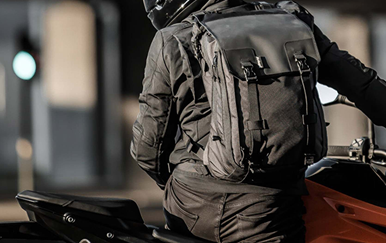A helmet is legally one of the only pieces of equipment you have to wear while riding a motorcycle. Will it prevent crashes? No, but it can protect you from serious injuries.
A good riding helmet can also improve your riding experience, shielding you from the weather and reducing rider fatigue. Whether you’re looking to spend £60 or £1000, there will always be something on the market just perfect for you.
If you want to know more about what other protective gear you should be investing in, feel free to check out our guide to must-have motorcycle accessories.
How do motorcycle helmets work?
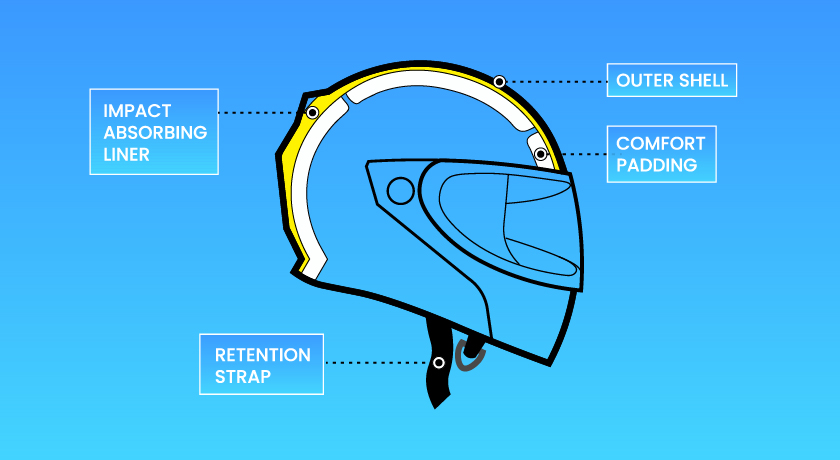
Regardless of whether you’re new to the biking world, or someone who has been a long-attending resident, it is always helpful to know what you're putting on your head to keep you safe.
There are four main components that work together to provide you with the ultimate protection:
- Outer Shell - The outer shell of a helmet is usually made from fiber-reinforced composites or thermoplastics. Designed to compress the moment it hits something hard, it dispenses energy from the impact to help lessen the force.
- Impact Absorbing Liner - Made from expanded polystyrene, the liner helps to cushion and absorb shock.
- Comfort Padding - The soft foam and cloth layer that sits next to your head not only helps to keep you comfortable but also to provide a snug fit (so you know that helmet isn’t going anywhere).
- Retention Strap - This part of the helmet is typically known as the ‘chin strap’, a visual part of the helmet helping to keep it on your head during a crash. Both the shell and the liner compress when hit hard, so it spreads the forces of impact throughout the helmet.
What helmets are legal in the UK?
There are several safety ratings that apply to motorcycle helmets. One of the essential ones while riding in the UK is the ECE standard. Any helmets that have not been tested by the ECE 22.05 are not legal for public use on roads.
Another motorcycle helmet safety rating you may come across while looking at helmets is DOT, which is an American classification. Legally, you cannot ride on the road with a DOT helmet in the UK, although that doesn’t stop some retailers from selling them - so be aware!
What style of motorcycle helmet should I choose?
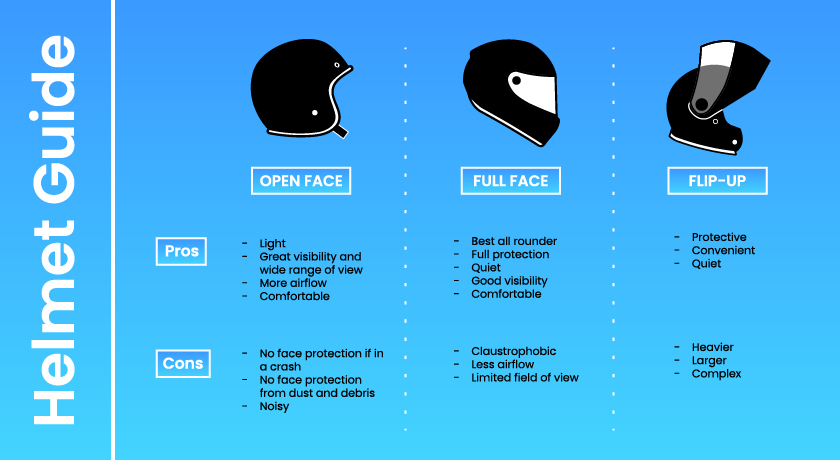
When it comes to helmets, essentially the choice is all yours. However, there are things to consider when deciding which helmet works for you. There are two distinct styles of helmet that are:
Open face Helmets
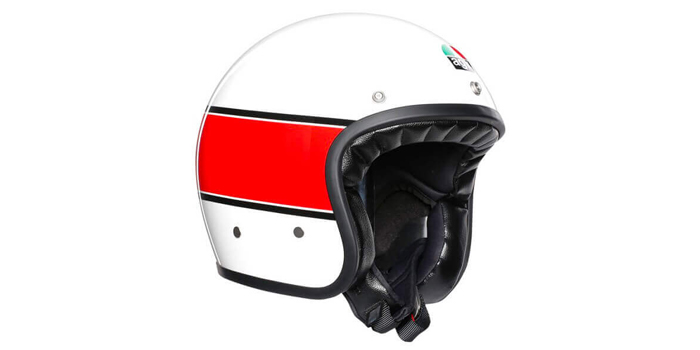
Open-face are the OG protective helmets. Classic, yet popular with custom riders, the open-face is perfect for getting the wind in your hair. Although that wind in your hair feeling may be cut short with the potential of dust and bugs hitting your face as you ride along…
Some open-face helmets will come with visors built-in, whereas others will require you to invest in separate goggles or a visor. If you do prefer an open-face helmet, it is important to have some kind of eye protection in place.
Another downside is the lack of a chin bar reduces the safety offered by these helmets in comparison to a full-face helmet.
Full Face Helmets
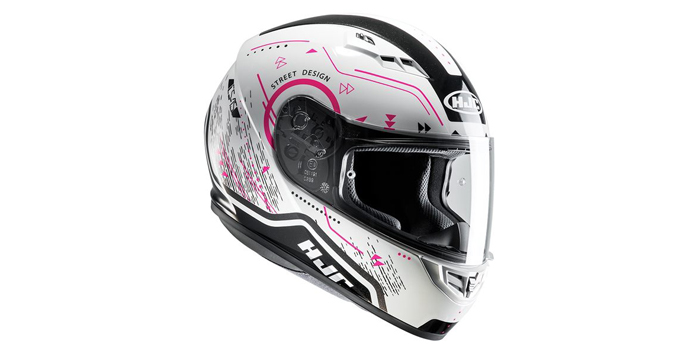
Full-face helmets are undeniably the best all-rounders. Ideal for all weather conditions, they provide a safe solution for every type of riding, meanwhile offering protection against the widest range of impact points. The main advantage of these helmets is the protection it offers for your chin and jaw which, if a crash should occur, could take some of the impact (but some might find that feeling quite claustrophobic)
If you are someone who hates that feeling of being tightly packed in, wider versions of full-face helmets are available in the shape of motocross and adventure-style helmets.
Motocross Style
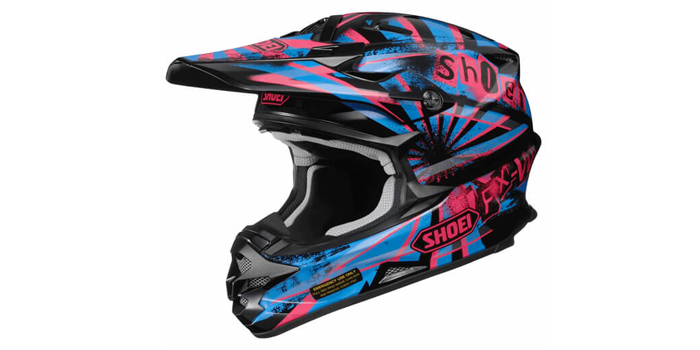
Motocross helmets tend to have defining features such as their high peak and elongated chin bar designed to maximise airflow. These types do not have a visor, instead, they are meant to be worn with goggles, offering that wind-in-your-face feeling we mentioned earlier, in a safer way.
There are also now dual-sport helmets that combine these with the full face style to create something that is more suited to road use. These dual-sport models have padding and full-face visors while retaining the cool MX style and functionality.
Flip-up (Modular)
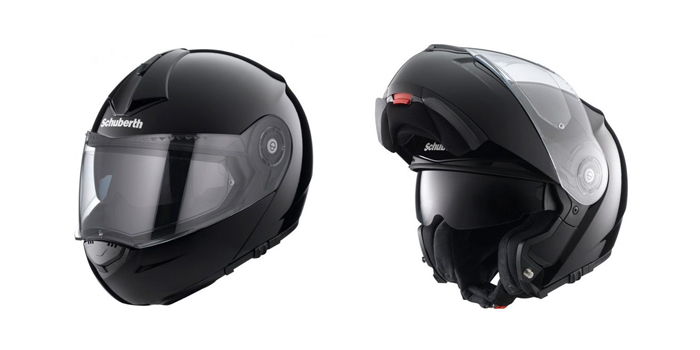
Half-way style helmets are essentially the same as a full face, but the chin guard and visor are hinged to, you guessed it, flip-up.
Popular for touring and commuting, with all of the capabilities of a full-face helmet, including the ability to be in open-face mode. Flip-fronts are also popular with riders who wear glasses, meaning they don’t have to remove their glasses while putting on their helmet.
The only negative to a flip-up is that it may have a very slightly heavier weight due to the extra hinge mechanisms.
How much should you spend?
As we mentioned earlier, the prices of motorcycle helmets can vary, from as little as £30 up to highs of £1000. Regardless of how much you spend though, all these helmets have had to pass a minimum safety standard, so it really depends on how much you want to pay, and what you can afford.
Cheaper models usually have an ABS or polycarbonate outer shell, but it can mean that your helmet is more vulnerable to degradation (typically from fuel) and cannot be painted.
As you can expect, the more expensive helmets will often have more expensive materials in their construction. An example of this is that composite shell helmets often use a mix of aramid fibres, fibreglass, carbon fibre, and other higher-quality materials. Another added bonus (if customisation is your cup of tea) is that they can be painted.
Which brand of motorcycle helmet is the best?
Some of the most popular and trustworthy brands include Shoei, Arai, HJC, Nolan, and Shark, to name a few off the top of my head - however, these brands might not necessarily be for you.
There are many models in each manufacturer's line that have slightly different styling and price points, which means you’ll most definitely find something perfect for you!
SHARP, the helmet safety scheme, can also help you find the right helmet from a wide variety of manufacturers, providing advice on how to select a helmet that fits correctly and is comfortable.
How do I choose a motorcycle helmet?
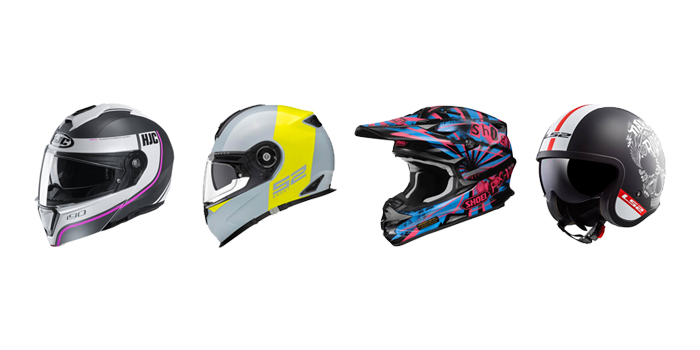
Finding the right helmet isn’t just for safety purposes, it’s also for comfort. So we’d recommend trying on a helmet before buying, and rather go into a local bike shop instead of buying online.
You can measure the circumference of your head, just above the eyes to try and work out your size. However, it should be noted that you will not be the same size helmet in every brand.
Your helmet should fit snugly with the padding around the cheek areas in contact with your skin. Once the chin strap is secure, you should not be able to pull the helmet away from your head and it also should not be able to twist loosely around your face. If you hold the helmet still and try to turn your head or if you shake your head around it should stay snug and in place.
Your helmet doesn't want to be too tight either, there should not be any pressure points causing discomfort as something like that can become a big deal when you're in the saddle for hours! A correctly fitting helmet should have its weight spread evenly around your head and not put too much pressure on your neck either. But by going to a dealer or motorcycle clothing store, most have assistants who will offer a fitting service to make sure you get the right size for you.
It’s important to mention that racer helmets often have tighter cheek pads to prevent the helmet from moving at higher speeds, some people find this slightly uncomfortable- so just remember to always try before you buy!
What is the law on tinted visors?
Whether you choose to ride with a visor or goggles, both must meet a British Standard and display a BSI Kitemark or meet the European standard offering (UNCE 22.05)
The legal rule regarding visors is that they must allow at least 50% light transmission- Legal tinted visors will be marked with ‘daylight use only’.
Do helmets really expire?
The answer is unfortunately yes.
Manufacturers recommend replacing your helmet every seven years (from the date of production). This is because the liner inside the helmet breaks down over time due to unavoidable sweat and oils, reducing the protection.
Although, if you wear your helmet daily, it is recommended you change your helmet every three years.
What should I do with my old helmet?
If you’re wondering what to do with your old helmet after you’ve purchased a shiny new one, there are plenty of things you can do with it:
- Donate it to emergency services
- Trade it in - some motorcycle shops can offer a discount on a new helmet
- Fancy dress- any Halloween or fancy dress parties coming up, go as the STIG?
Motorcycle helmet maintenance
If you are wearing your helmet during those hotter and longer rides, sweating is unavoidable (especially with this ongoing heatwave). It is important to know how to clean your helmet effectively to boost its longevity.
How to clean:
- Removable interior/ liner - This can be washed by hand or in the washing machine (on a gentle heat)
- Outside exterior - Can be washed with a special helmet cleaner or mild soap.
- No strong detergents - Any strong detergents or bleach can affect and potentially damage the helmet
- Drying - When drying it is important to place the helmet away from heat, as it may cause the glue to melt and weaken.
Things to remember
So, there we have it, the guide to motorcycle helmets is complete. A few important things to remember are:
- Do not store your helmet near fuel, cleaning materials, or heat
- Don’t attach stickers or paint as it can damage infrastructure (Unless the helmet is stated safe to do so)
- The higher the price of the helmet does not equal the comfiest or the safest, go what fits and works for you best
- Carry your helmet correctly (strap up, wear it like a handbag)
- Do not store your gloves or anything else inside your helmet - protect that lining from deteriorating.
- Don’t forget, if it gets to that certain age or has sustained a drop or crash the helmet should be replaced
Final Stop
Most importantly, wearing a crash helmet can make all the difference to your safety in case you have an unfortunate incident. Another way to reduce the risks associated with accidents is to seek motorcycle insurance - make sure to get a quote direct with Lexham!


